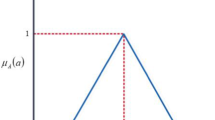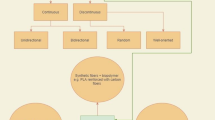Abstract
A new model is constructed to validate a non-linear elastic response of rubber-like materials. The proposed model is phenomenological and is the combination of Rivlin expression truncated in invariant \(\mathop I\nolimits_{1}\) with a term in \(\mathop I\nolimits_{2}\) coming from the Hart-Smith model and which has been modified by Gornet et al. This model has five rheological parameters adjusted with a genetic algorithm. The genetic algorithm method is used in binary code and two sets of experimental data (Treloar data and Nunes and Moreira data) from the literature to compare the proposed model. With Treloar rubber data the simple tension suffices for the determination of the parameter values. Thus, the fit of experimental data is shown to provide an accurate response and predictive description in biaxial tension and pure shear with the same sets of material parameters. Unlike, with Moreira data, the proposed model has given direct material parameters in simple shear with good correlation. On the other hand, a comparison is made between the proposed model and the Beda model (2007), Gornet et al. model and hybrid integral approach (HIA) model. The proposed model is the most efficient among three other classical models because the proposed model emerges from very small relative errors with Treloar's experimental data: 0.42 ± 0.08 in simple tension, 0.44 ± 0.07 in biaxial tension and 0.42 ± 0.05 in pure shear. This model also incorporates all the criteria for model validation described in the literature.









Similar content being viewed by others
References
Rivlin RS (1948) Large elastic deformations of isotropic materials: fundamental concepts. Philos T R Soc Lond 240:459–490
Isihara A, Hashitsume N, Tatibana M (1951) Statistical theory of rubber-like elasticity: IV two-dimensional stretching. J Chem Phys 19:508–1512
Yeoh OH, Fleming PD (1997) A new attempt to reconcile the statistical and phenomenological theories of rubber elasticity. J Polym Sci Part B 35:1919–1931
James AG, Green A, Simpson GM (1975) Strain energy functions of rubber: I. Characterization of gum vulcanizates. J Appl Polym Sci 19:2033–2058
Lion A (1997) Pergamon on the large deformation behaviour of reinforced rubber at different temperatures. J Mech Phys Solids 45:1805–1834
Haupt P, Sedlan K (2001) Viscoplasticity of elastomeric materials: experimental facts and constitutive modelling. Arch Appl Mech 71:89–109
Pucci E, Saccomandi G (2002) A note on the gent model for rubber-like materials. Rubber Chem Technol 75:39–51
Beda T (2005) Reconciling the fundamental phenomenological expression of the strain energy of rubber with established experimental facts. J Polym Sci Part B 43:125–134
Beda T (2007) Modeling hyperelastic behavior of rubber: a novel invariant based and a review of constitutive models. J Polym Sci Part B 45:1713–1732
Nunes LCS (2011) Mechanical characterization of hyperelastic polydimethylsiloxane by simple shear test. Mater Sci Eng A 528:1799–1804
Bien-aimé LK, Blaise BB, Beda T (2019) Comparison of continuum constitutive hyperelastic models based on exponential forms. Int J Innov Sci Res Technol 4:1360–1367
Külcü ID (2019) A hyperelastic constitutive model for rubber-like materials. Arch Appl Mech 90:615–622
Valanis KC, Landel RF (1967) The strain energy function of a hyperelastic material in terms of the extension ratios. J Appl Phys 38:2997–3002
Peng T, Landel R (1972) Stored energy function of rubberlike materials derived from simple tensile data. J Appl Phys 43:3064–3067
Ogden RW (1972) Large deformation isotropic elasticity: on the correlation of theory and experiment for compressible rubberlike solids. Proc R Soc A328:567–583
Arruda E, Boyce M (1993) A three dimensional constitutive model for the large stretch behavior of rubber elastic materials. J Mech Phys Solids 41:389–412
Mooney M (1940) A theory of large elastic deformation. J Appl Phys 11:582–592
Nguessong Nkenfack A, Beda T, Feng ZQ, Peyraut F (2016) HIA: a hybrid integral approach to model incompressible isotropic hyperelastic materials-part 1: theory. Int J Non-Linear Mech 84:1–11
Marckmann G (2006) Contribution a l'etude des elastomeres et des membranes soufflees. Ecole Centrale de Nantes (ECN), Université de Nantes, thesis
Beda T (2014) An approach for hyperelastic model-building and parameters estimation a review of constitutive models. Eur Polym J 50:97–108
Gornet L, Marckmann G, Desmorat R, Charrier P (2012) A new isotropic hyperelastic strain energy function in terms of invariants and its derivation into a pseudo-elastic model for Mullins effect. In: Jerrams S, Murphy N (eds) Constitutive models for rubber VII. CRC Press, Boca Raton, pp 265–272
Treloar LRG (1944) Stress-strain data for vulcanized rubber under various types of deformation.Trans Faraday Soc 40:59–70
Nunes LCS, Moreira DC (2013) Simple shear under large deformation: experimental and theoretical analyses. Eur J Mech A Solids 42:315–322
Boyce MC, Arruda EM (2000) Constitutive models of rubber elasticity: a review. Rubber Chem Technol 73:504–523
Lahellec N, Mazerolle F, Michel JC (2004) Second-order estimate of the macroscopic behavior of periodic hyperelastic composites: theory and experimental validation. J Mech Phys Solids 52:27–49
Hart-Smith LJ (1966) Elasticity parameters for finite deformations of rubber-like materials. Z Angew Math Phys 17:608–626
Harb N, Labed N, Domaszewski M, Peyraut F (2011) A new parameter identification method of soft biological tissue combining genetic algorithm with analytical optimization. Comput Methods Appl Mech Eng 200:208–215
Blaise BB, Betchewe G, Beda T (2019) Optimization of the model of Ogden energy by the genetic algorithm method. Appl Rheol 29:21–29
Blaise BB, Betchewe G, Beda T (2019) Optimisation of the Ogden model energy by the genetic algorithm method. LAP Lambert Academic, Germany
Holland JH (1975) Adaptation in natural and artificial systems. University of Michigan, Ann Arbor
Zames G, Ajlouni NM, Holland JH, Hills WD, Goldberg DE (1981) Genetic algorithms in search,optimization and machine learning. Info Technol J 3:301–302
Matlab (2013) The Language of Technical Computing. Copyright (c) 1984–1999 by The MathWorks, Inc. Version 5.3.0.10183 (R11)
Barghamadi M, Karrabi M, Ghoreishy MHR, Mohammadian-Gezaz S (2019) Effects of two types of nanoparticles on the cure, rheological, and mechanical properties of rubber nanocomposites based on the NBR/PVC blends. J Appl Polym Sci 136:1–11
Barghamadi M, Ghoreishy MHR, Karrabi M, Mohammadian-Gezaz S (2019) Investigation on the kinetics of cure reaction of acrylonitrile–butadiene rubber (NBR)/polyvinyl chloride (PVC)/graphene nanocomposite using various models. J Appl Polym Sci 137:1–11
Treloar LRG (1954) The photoelastic properties of short chain molecular networks. Trans Faraday Soc 50:881–896
Treloar LRG (1973) The elasticity and related properties of rubbers. Rep Prog Phys 36:755–826
Author information
Authors and Affiliations
Corresponding author
Rights and permissions
About this article
Cite this article
Blaise, B.B., Bien-aimé, L.K.M., Betchewe, G. et al. A phenomenological expression of strain energy in large elastic deformations of isotropic materials. Iran Polym J 29, 525–533 (2020). https://doi.org/10.1007/s13726-020-00816-6
Received:
Accepted:
Published:
Issue Date:
DOI: https://doi.org/10.1007/s13726-020-00816-6




